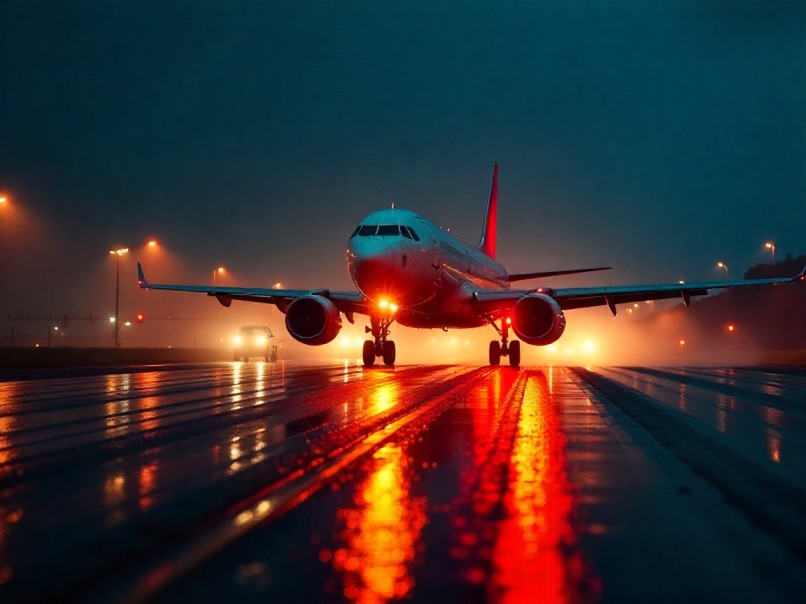Published on
August 26, 2025

On 26 August, travel across China was severely disrupted as Shanghai Airlines, China Express and China Eastern grounded fifty flights, leaving passengers stranded in multiple cities. The cancellations, which included key routes from major airports like Shanghai, Shenzhen and Chengdu, affected travelers across a wide range of destinations. Cities like Shanghai, Luoyang, Shenzhen, Yuncheng, Quanzhou, Kunming, Xining, Xi’an, Hangzhou, Guangzhou, Hefei, Nanjing, Shenyang, Chengdu, Beijing, Wuhu, Hohhot, Chifeng, Changsha, Changzhi, Lüliang, Chongqing, Zhoushan, Xishuangbanna, Tianjin and Zhanjiang were all impacted by the widespread interruptions.
According to FlightAware data, the cancellations have caused widespread delays and frustration among travelers, with a total of 1201 Delays and 50 Cancellations, both domestic and international routes were disrupted. The scale of this issue highlights the broader impact on passengers across these key regions. In this report, we will explore the details of these cancellations, how travelers are affected and the local tourism implications for these cities.
The disruptions began with China Eastern Airlines, China Express Airlines and Shanghai Airlines grounding several flights across various routes. The total number of cancellations reached fifty, severely affecting both domestic and international travel within China.
China Eastern Airlines had 42 flight cancellations and 902 delays, affecting a variety of routes within the country. Key cancellations included routes from Shanghai Hongqiao International Airport to cities such as Luoyang, Quanzhou, Yuncheng and Xi’an. For instance, flights like CES5361 (Shanghai to Luoyang) and CES6731 (Yuncheng to Shanghai) were among those affected. Passengers traveling from Kunming to Xining and vice versa were also impacted by the flight cancellations.
China Express Airlines experienced 5 cancellations and 157 delays. The cancelled flights included those from Hohhot to Chifeng, Wuhu to Changsha and Changsha to Wuhu, among others. Flights like HXA2791 (Hohhot to Chifeng) and HXA4245 (Wuhu to Changsha) were particularly affected, causing significant inconvenience for travelers on these routes.
Shanghai Airlines saw 3 of its flights grounded, with 142 delays also reported. Notable cancellations included flights from Shanghai Pudong to Zhanjiang and Tianjin, such as CSH9359 (Shanghai to Zhanjiang) and CSH9119 (Shanghai to Tianjin).
The disruptions impacted multiple domestic routes that are integral to China’s transportation network. The cancellations were spread across major cities, as well as regional and secondary destinations.
In particular, China Eastern Airlines saw cancellations across its domestic flights, including routes such as Shanghai to Luoyang, Shanghai to Xi’an and Kunming to Xining. These routes connect major metropolitan hubs with regional cities, making them critical for business, leisure and tourism travel.
China Express Airlines also had its share of impacted routes, including flights from Hohhot to Chifeng and from Wuhu to Changsha. These routes are essential for connecting smaller cities to major metropolitan areas in China and the cancellations disrupted many local travelers.
Shanghai Airlines’ cancellations predominantly affected flights between Shanghai and Zhanjiang, as well as Shanghai and Tianjin. These routes are significant for both business travel and domestic tourism.
The scale of delays was extensive, with a total of 1201, among which 902 delays reported by China Eastern Airlines alone. Passengers across China experienced disruptions in their travel plans, often waiting hours for rescheduled flights or rebooking options. The delays were not confined to any particular airport, as flights from Shanghai Pudong International, Shanghai Hongqiao, Kunming Changshui and Chengdu Shuangliu experienced significant delays.
China Express Airlines also saw 157 delays, with passengers waiting long hours for updates. The delays were particularly noticeable on domestic routes, where passengers were already dealing with cancellations. These delays further extended the travel time for passengers and caused confusion at many affected airports.
Shanghai Airlines, with 3 cancelled flights, also reported 142 delays, though on a smaller scale. Despite the limited number of cancellations, the impact on passengers traveling between Shanghai, Zhanjiang and Tianjin was still significant, especially considering the limited number of alternative options for affected travelers.
Several airports across China were affected by the flight disruptions, with some facing more severe impacts than others. Among the most disrupted were the major airports in Shanghai, including Shanghai Pudong International and Shanghai Hongqiao International. Both airports, being key hubs for domestic and international flights, saw cancellations and delays impacting thousands of travelers.
Other affected airports included:
- Kunming Changshui International: This airport, a critical point for flights to and from southwestern China, had significant delays on its routes, especially those to Xining.
- Chengdu Shuangliu International: Flights from Chengdu to destinations such as Kunming were delayed, leading to overcrowding and confusion.
- Xi’an Xianyang International: The airport saw cancellations on several routes, particularly those to and from Shanghai.
- Changsha Huanghua International: This airport faced disruptions on domestic flights to and from cities like Wuhu and Shanghai.
- Wuhu Xuanzhou: Though a smaller airport, it was notably impacted by flight cancellations, particularly on its routes to Changsha and other cities.
These airports, already bustling with daily operations, had to deal with the backlog of affected passengers. Many travelers had to adjust their travel plans, leading to longer waits and rescheduled flights.
For passengers affected by the cancellations and delays, it is important to remain patient and proactive. Here are some steps that affected travelers can take:
- Check for Alternative Flights: Many passengers were rebooked on alternative flights by their respective airlines. For those who have not been rebooked, it is advised to check with airline counters or customer service for options.
- Monitor Flight Status: Travelers should stay updated on flight status through official airline websites or apps. Airlines often provide real-time updates on cancellations and delays.
- Claim Compensation: Depending on the airline’s policy, passengers may be entitled to compensation for cancellations or extensive delays. This could include vouchers, meal allowances, or even hotel accommodation in cases of overnight delays.
- Contact the Airline: Passengers should contact their airlines for information about rebooking, refunds, or travel credits. Some airlines offer online tools to rebook or change flights without waiting in line at the airport.
- Stay Informed on Local Travel and Health Protocols: As some of the affected cities are tourist destinations, it is essential to stay updated on any local travel restrictions, especially regarding health protocols that may affect airport operations.
Tourism in many of the affected cities could feel the strain from these travel disruptions. Cities such as Shanghai, Xi’an, Chengdu and Kunming, which typically attract international tourists, could see a temporary slowdown in visitor arrivals due to the cancellations and delays.
Tourism hotspots such as Xi’an, known for the Terracotta Army and Chengdu, famous for its panda reserves, could see fewer visitors, as both local and international tourists may face challenges in reaching these destinations. Similarly, Shanghai, a global financial hub and a popular tourist destination, may see disruptions in its tourist activities as flights to and from the city are delayed or cancelled.
Kunming, with its scenic landscapes and cultural attractions and Xi’an, known for its rich historical heritage, are also likely to experience a drop in visitors due to the cancellations, which could have short-term economic impacts.
For smaller cities like Hohhot, Zhanjiang and Wuhu, the disruption could mean a loss of regional tourism income. These cities, while not international tourism hotspots, depend on domestic travel for their local economies, which are likely to suffer as a result of these cancellations.
The travel disruptions caused by Shanghai Airlines, China Express and China Eastern on Tuesday, 26 August, have left many passengers stranded and uncertain about their travel plans. With fifty flights grounded and numerous delays recorded across major cities such as Shanghai, Luoyang, Shenzhen and others, the scale of the chaos has been extensive. As highlighted by FlightAware data, these interruptions have not only affected domestic routes but also impacted international travel, leading to widespread frustration. Passengers are advised to stay informed about their flight status and rebooking options, while the tourism industry in these affected cities may experience a temporary slowdown. The full extent of the disruptions underscores the importance of proactive communication between airlines and travelers, as this situation continues to evolve.






